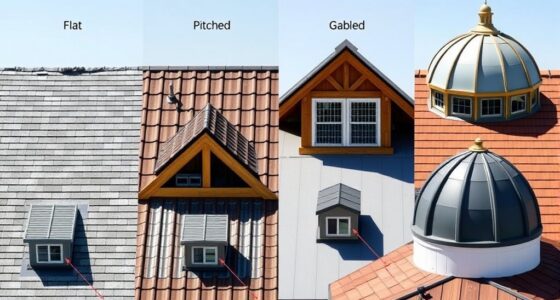When choosing transit lighting, LED packages stand out for their high energy efficiency, longer lifespan, and brighter, whiter light that boosts safety. Halogens are budget-friendly and simple to install but require frequent replacements and produce more heat. HIDs offer powerful illumination with better efficiency than halogens but have more complex setups and moderate durability. Exploring these options further can help you find the best fit for your transit needs.
Key Takeaways
- LED lighting offers superior energy efficiency, longer lifespan, and better visibility compared to halogen and HID options.
- Halogen lights are budget-friendly and simple to install but require frequent replacements due to shorter lifespans.
- HIDs provide high brightness and good efficiency but involve more complex installation and maintenance.
- LEDs generate less heat, reducing safety risks and electrical system strain in transit applications.
- Overall, LEDs are the most cost-effective and durable choice for transit lighting packages long-term.

When choosing lighting packages for transit vehicles, understanding the differences between halogen, LED, and HID options is essential for making an informed decision. Each type offers unique advantages and drawbacks that can considerably impact your vehicle’s performance, safety, and maintenance costs.
Halogen lights are the traditional choice, known for their affordability and straightforward design. They produce a warm, yellowish light that’s easy to install and replace. However, they tend to be less energy-efficient, drawing more power and generating more heat, which can lead to higher fuel consumption and potential overheating issues. Their lifespan is relatively short—usually around 500 to 1,000 hours—meaning you’ll need to replace bulbs more frequently, adding to maintenance costs over time.
Halogen lights are budget-friendly but have shorter lifespans and lower energy efficiency.
LED lighting has become increasingly popular in transit applications due to its efficiency and durability. You’ll find LED lights consuming considerably less power than halogens, which means better fuel economy and less strain on your vehicle’s electrical system. They produce a brighter, whiter light that enhances visibility for both drivers and passengers, especially in poor weather conditions or at night.
LEDs also generate less heat, reducing the risk of heat-related damage to components and improving overall safety. Their lifespan is impressive—often exceeding 25,000 hours—meaning fewer replacements and lower long-term maintenance expenses. Additionally, LEDs are more resistant to shock and vibration, common in transit environments, ensuring consistent performance even under rough conditions.
HID lights, or high-intensity discharge lamps, sit somewhere between halogens and LEDs in terms of brightness and efficiency. They produce a very intense, bluish-white light that offers excellent illumination for transit vehicles, especially in high-traffic or poorly lit areas. HIDs are more energy-efficient than halogens but typically less so than LEDs.
They also take a few seconds to warm up to full brightness, which might be a consideration for quick-start situations. Maintenance for HID systems can be more complex and costly, as they require ballasts and precise handling during replacement. Their lifespan generally falls between that of halogens and LEDs, usually around 2,000 to 3,000 hours.
In making your choice, consider your budget, maintenance capacity, safety priorities, and operational environment. If you prioritize long-term savings and durability, LEDs are the clear winner. For lower initial costs and simpler installation, halogens might suffice, but keep in mind they’ll require more frequent replacements.
HIDs can be suitable if you need high-intensity illumination but are prepared for the extra maintenance. Additionally, understanding the technology differences between these lighting options can help you select the most efficient and reliable solution for your needs. Ultimately, understanding these differences helps you select the best lighting package for your transit vehicle’s specific needs, balancing upfront costs with long-term benefits.
Frequently Asked Questions
How Do Maintenance Costs Compare Across Halogen, LED, and HID Lighting?
You’ll find that LED lighting typically costs less to maintain than halogen and HID options. LEDs are more durable, resist vibrations, and have longer lifespans, reducing replacement frequency.
Halogen bulbs burn out quicker, leading to higher maintenance costs over time. HID lights last longer than halogens but still require more frequent attention than LEDs.
Are There Any Legal Restrictions on Using Certain Lighting Types on Transit Vehicles?
Think of your transit vehicle as a ship steering through strict maritime laws. Certain lighting types, like HID or high-intensity LEDs, may be restricted or require specific certifications to meet safety standards.
You should check local regulations, federal guidelines, and transit authority rules before installing or using these lights.
Ignoring restrictions could lead to fines or safety issues, so stay informed and make certain your vehicle’s lighting complies with all legal requirements.
Which Lighting Package Offers the Best Visibility in Adverse Weather Conditions?
LED lighting offers the best visibility in adverse weather conditions, thanks to its brighter, more focused beam and faster response time. You’ll notice clearer illumination during rain, fog, or snow, helping you see hazards sooner.
Unlike halogen or HID lights, LEDs cut through poor weather with less glare and better color accuracy. So, if visibility in tough conditions matters most, choosing LED lighting on your transit vehicle is the smart, safer choice.
How Do Initial Installation Costs Vary Between the Three Lighting Options?
You’ll find that halogen lights have the lowest initial costs, making them budget-friendly upfront.
LEDs, while more expensive initially, offer longer-lasting performance and energy savings, which can offset the higher price over time.
HIDs tend to fall in between, with moderate installation costs and better brightness than halogens.
What Are the Environmental Impacts of Each Lighting Technology?
You’ll find that LEDs have the lowest environmental impact because they consume less energy and last longer, reducing waste.
HIDs use more energy and contain hazardous materials like mercury, making disposal more problematic.
Halogens are less efficient and have a higher carbon footprint due to increased energy use.
Choosing LED lighting helps you reduce your transit system’s carbon emissions and minimizes environmental harm over time.
Conclusion
Choosing between halogen, LED, and HID lighting for your transit depends on your priorities. LEDs often prove more efficient and long-lasting, making them a smart choice for those seeking reliability. HIDs offer brighter illumination but can be pricier and less durable. Halogens, while affordable, don’t last as long. Ultimately, investing in LEDs balances performance and cost, ensuring you get the best value. So, weigh your needs carefully—your transit’s safety and efficiency depend on it.









